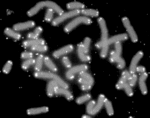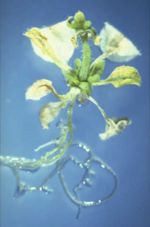Senescence
Senescence is the process of the aging of cells which eventually leads to cell death. Many people think that if senescence was prevented, people could live much longer, if not forever. There is even an area of science, called gerontology, that studies the aging process in order to prevent age-related diseases and disabilities.
Cellular Senescence
Cellular senescence is the reproduction limits of normal cells. Most normal cells can divide up to 40 or 60 times before they are unable to divide anymore. This is referred to as he Hayflick Limit, after Dr. Leonard Hayflick who discovered cellular senescence. Some cells do not have this limit, though. These cells are cancer cells, and they can divide infinitely. [1]
Senescence is thought to be due to the degradation of telomeres. Telomeres are caps at the end of chromosomes that prevent chromosomes from fusing together. After each division of the cell, the length of the telomere shortens. When the telomere is finally gone, the cell cannot divide anymore and dies. Cancer cells can avoid this eventual death by introducing telomerase into its cells. Telomerase is a reverse-transcriptase enzyme that makes the telomeres longer after each division, thus preventing them from disappearing. [2]
Senesence Hormones
Ethylene is an important senescence hormone in plants because it stimulates plant growth and speeds up the process of apoptosis. Ethylene also is involved in the abscission of leaves and the fading of flowers.
Apoptosis
- Main Article: Apoptosis
Programmed cell death is called apoptosis. This is commonly seen in plants, but can happen in all kinds of organisms. There are two main reasons for an organism to kill its own cells: It is needed for proper development, and it is needed to destroy cells that pose a threat to the entire organism. This can be seen in the development of the human brain, where synapses must form by getting rid of surplus cells through apoptosis, or destroying cancer cells or cells infected with viruses through induced apoptosis. [3]
There are three different ways that a cell can start the process of apoptosis. The first is to trigger it by sending internal signals through the mitochondrial pathway. The second way is through external signals through the death receptor pathway. Finally, the cell can trigger apoptosis through an inducing factor. [4]
| External Signals | Internal Signals | Inducing Factors |
|---|---|---|
| Fas and the TNF receptor are integral membrane proteins with their receptor domains exposed at the surface of the cell
binding of the complementary death activator (FasL and TNF respectively) transmits a signal to the cytoplasm |
In a healthy cell, the outer membranes of its mitochondria display the protein Bcl-2 on their surface | AIF is released from the mitochondria (like the release of cytochrome c in the first pathway) |
| This leads to the activation of caspase 8 | Internal damage to the cell (e.g., from reactive oxygen species) causes
Bcl-2 to activate a related protein, Bax, which punches holes in the outer mitochondrial membrane, causing cytochrome c to leak out |
It then migrates into the nucleus |
| Caspase 8 (like caspase 9) initiates a cascade of caspase activation leading to
phagocytosis of the cell |
The released cytochrome c binds to the protein Apaf-1 ("apoptotic protease activating factor-1") | And binds to DNA |
| Using the energy provided by ATP, these complexes aggregate to form apoptosomes | Which triggers the destruction of the DNA and cell death | |
| The apoptosomes bind to and activate caspase-9 | ||
| Caspase-9 is one of a family of over a dozen caspases. They are all proteases. They get their name because they cleave proteins — mostly each other — at aspartic acid (Asp) residues) | ||
| Caspase-9 cleaves and, in so doing, activates other caspases (caspase-3 and -7) | ||
| The activation of these "executioner" caspases creates an expanding cascade of proteolytic activity (rather like that in blood clotting and complement activation) which leads to digestion of structural proteins in the cytoplasm, degradation of chromosomal DNA, and phagocytosis of the cell |
Related References
- Senescence and the Biology of Human Aging Senescence Info
- Aging Aging Research Center
- American Federation for Aging Research InfoAging
- Apoptosis Biology Pages
- Ethylene Botany Online
 Browse |


